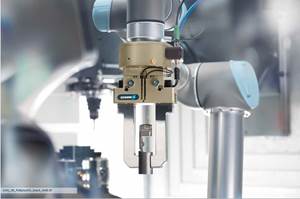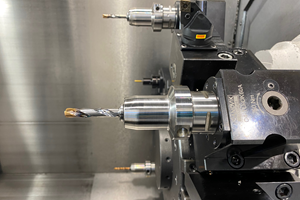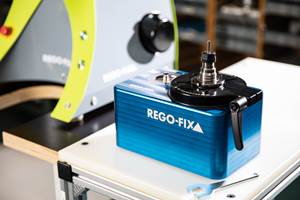Smart Boring Bar Auto-Comps
Because boring is a finishing or semi-finishing operation, there is generally little or no margin for dimensional or surface finish error. In production, dimensional accuracy of a precise bore can be negatively affected by tool wear over time.
Share





Because boring is a finishing or semi-finishing operation, there is generally little or no margin for dimensional or surface finish error. In production, dimensional accuracy of a precise bore can be negatively affected by tool wear over time.
The goal is to track the tool wear in a predictable manner using SPC or other trend analysis techniques to determine when the boring bar needs to be compensated for tool wear and build the tool comp into the process. There are a number of methods to gather this tool wear data. These include in-process gaging, time-in-cut tables and acoustical analysis, all of which can tell the machinist a cutter is wearing near the upper tolerance limit.
In general manufacturing, once a tool comp is required, the machine tool operation must stop for operator intervention. For very precise boring, often the machine tool's resolution is insufficient for the very fine adjustment required.
In close tolerance boring, adjustable boring heads are used to provide very tiny radial adjustments that are outside the ability of the machine tool. Komet of America (Schaumburg, Illinois) recently introduced a new adjustable boring system that is capable of making tool compensation moves automatically, on the machine, without the need for operator intervention. Called the M042, this boring head is a marvel of miniaturization. Within its body is an electronic servomotor, slide system, infrared transceiver module for remote data signal reception and an integral inductive scale that gives absolute positioning for the cutter tip. The entire boring bar unit is designed to operate within an automatic tool changer system on a machining center. It is also built to operate in the harsh production machining environments of flex lines and special and transfer machines.
Komet's automatic compensating system is designed for fully automatic or unattended precision positioning of the cutting insert for finish boring operations. The system consists of an integral positioning mechanism, gaging equipment to measure and trend the workpiece bore, a control-unit and the boring bar itself.
Unlike most other auto-comp systems that use mechanical or hydraulic actuation of the tool slide, the electronic system is less influenced by outside parameters such as thermal growth. Moreover, the integral inductive scale provides absolute positioning feedback to the control unit.
If a positioning error occurs, the system software will send an error alert or re-try the programmed move. Using a scale system to measure absolute movement prevents mechanical errors caused by backlash or thermal distortion from transferring to the tool tip. The M042 has a stroke of 1 mm and can move in 1 micron increments.
A variety of gaging systems can be used with the auto-comp system. Its software is compatible with most protocols so gaging and compensation can be integrated. One auto-comp boring bar and gaging system for machining centers uses an automatic tool changeable plug gage to check the bore before and after machining. It then feeds the trending data back through the control and will automatically signal the need for a tool wear compensation routine when set parameters are hit. Another gaging variation accomplishes the same closed loop compensation feedback using a table mounted laser gage or touch gage to directly measure the cutting insert for wear without the need to interchange the cutting tool for a plug gage.
One M042 control unit can accommodate 15 boring units at a time. For tight tolerance boring where automation of the tool compensation routine makes sense, this unit may be a viable step forward. It would appear that smart tools are here.
Related Content
Lean Approach to Automated Machine Tending Delivers Quicker Paths to Success
Almost any shop can automate at least some of its production, even in low-volume, high-mix applications. The key to getting started is finding the simplest solutions that fit your requirements. It helps to work with an automation partner that understands your needs.
Read MoreForm Tapping Improves Tool Life, Costs
Moving from cut tapping to form tapping for a notable application cut tooling costs at Siemens Energy and increased tool life a hundredfold.
Read MoreOrthopedic Event Discusses Manufacturing Strategies
At the seminar, representatives from multiple companies discussed strategies for making orthopedic devices accurately and efficiently.
Read MoreFive Common Mistakes Shops Make with ER Collets (And How to Prevent Them)
Collets play a crucial role in the machining process, so proper tool assembly and maintenance is important. Here are five potential pitfalls to avoid when using ER collets.
Read MoreRead Next
Last Chance! 2025 Top Shops Benchmarking Survey Still Open Through April 30
Don’t miss out! 91ÊÓƵÍøÕ¾ÎÛ's Top Shops Benchmarking Survey is still open — but not for long. This is your last chance to a receive free, customized benchmarking report that includes actionable feedback across several shopfloor and business metrics.
Read MoreAMRs Are Moving Into Manufacturing: 4 Considerations for Implementation
AMRs can provide a flexible, easy-to-use automation platform so long as manufacturers choose a suitable task and prepare their facilities.
Read MoreMachine Shop MBA
Making Chips and 91ÊÓƵÍøÕ¾ÎÛ are teaming up for a new podcast series called Machine Shop MBA—designed to help manufacturers measure their success against the industry’s best. Through the lens of the Top Shops benchmarking program, the series explores the KPIs that set high-performing shops apart, from machine utilization and first-pass yield to employee engagement and revenue per employee.
Read More






















